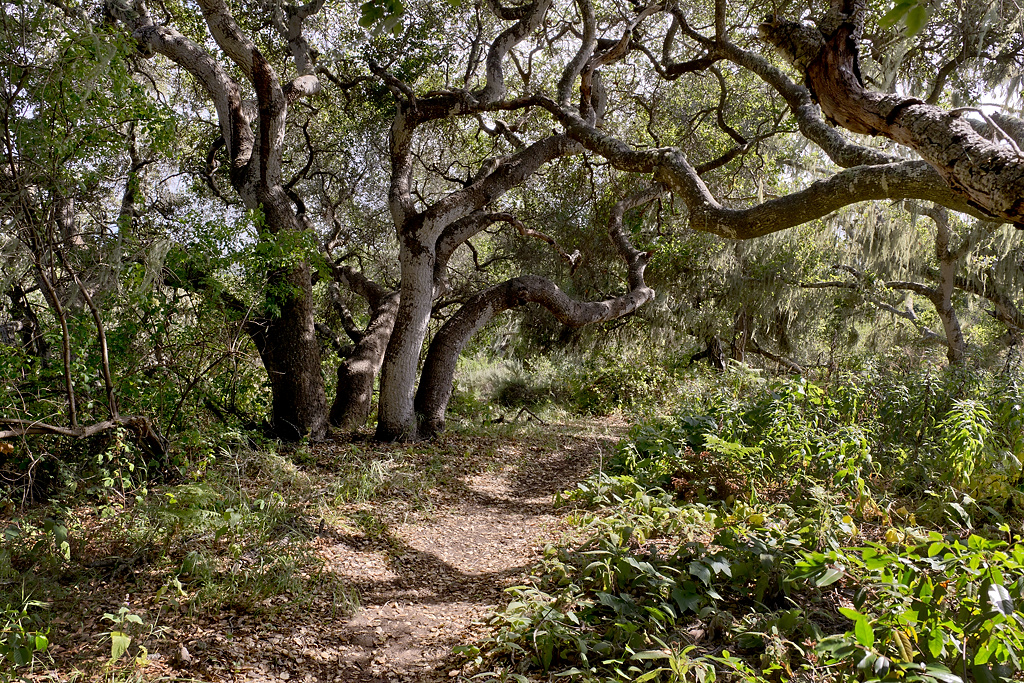Notices:
- No camping at the reserve. For camping nearby please contact Montaña de Oro, Morro Bay or Morro Strand Campgrounds.
- No campfires permitted.
- No dogs allowed on trails or to be left unattended in vehicles. Laws enforced.
- Bicycles and equestrians are not permitted.
- The reserve has no restrooms or facilities for picnicking.
- Stay on trails to avoid poison oak and ticks that may carry Lyme disease.
In 1769, Gaspar de Portola's expedition passed through the Los Osos Valley. Father Crespi's diary notes that the expedition saw "troops of bears (osos)" in the valley, and since then it became known as the Los Osos Valley. When the new Monterey mission populace faced starvation, an expedition was sent to the Los Osos Valley, hunted many grizzlies, and packed the meat back to Monterey, saving the people there from disaster.
Los Osos Oaks was part of a Mexican land grant that was eventually divided into farm and ranchland. Incredibly, unlike the trees in the surrounding area which were cleared away to allow for agriculture, the magnificent oaks in the park are still growing.
Today, Los Osos Oaks State Natural Reserve features ancient sand dunes covered with centuries-old coast live oak trees. According to botanists, five major plant communities thrive within the reserve. They are coastal sage scrub, central coastal scrub, dune oak scrub, coast live oak forest, and riparian (streamside). The oak communities exist close to each other, but each has its own character. The oak scrub has dwarf oak trees growing on the ancient (relict) sand dunes. Though they are coast live oak trees, they rarely grow more than six to eight feet tall. The larger coast live oaks are located where the soil is moister. These giants can grow to 25 feet in height. Their massive trunks and gnarled branches twist into all sorts of fantastic shapes. Coast live oak woodland provides food and shelter for many birds, mammals and insects. More wildlife is visible in spring and fall. The hour after sunrise and the hour before sunset are optimal times for viewing wildlife.
Seasons - Climate - Recommended clothing
Los Osos Oaks SNR has moderate weather. During summer days, the area is often cooler than inland areas. Layered clothing is recommended.
Location & Directions
Los Osos Oaks State Natural Reserve is located:
- 9 miles west of San Luis Obispo on Los Osos Valley Rd.
- 35.5 miles south of the Hearst San Simeon State Historical Monument Visitor Center on Highway 1 to South Bay Blvd., turn right on Los Osos Valley Rd.
- 129 miles south of Monterey through Big Sur via Highway 1 (When road conditions permit)
- The small town of Los Osos is located 1.5 miles to the west and offers gas stations, grocery stores, and dining options.
- The oceanside community of Morro Bay is located 6 miles to the north and offers even more gas stations, grocery stores, and dining.
Facilities - Activities
Hiking
At the beginning of the reserve's trail, traffic noise from the busy road dominates. Penetrating deeper into the park, these sounds diminish, giving way to birds singing, water trickling in Los Osos Creek, and wind rustling through the oaks. Trails traverse through the variety of plant communities, and the trail is alternately in bright sunlight or dappled shade. A word of caution: one of the predominant undergrowth plants in the area is poison oak. A sign at the entrance helps visitors identify and stay away from this plant. Staying on the trails helps to avoid contact.
One of the trails goes through remnants of an old Chumash Indian midden (trash dump) site. Fragments of clam and abalone shells the Chumash consumed long ago are found here. The nomadic Chumash had temporary encampments all over the Morro Bay watershed area, and this is just one reminder that many other people have come before us.
There is a variety of wildlife in the park. Visitors can spot a shy plain titmouse or see a California valley quail rustling through the underbrush. Visitors may also see a brush rabbit darting across the trail or encounter the home of a nocturnal dusky-footed wood rat.
The Reserve is also the home of several species of lichen that can be found nowhere else. Visitors should look for wisps of lichens and mosses dangling from oak branches throughout the reserve.
The Reserve is within minutes of Montaña de Oro State Park, Point Buchon Trail, El Moro Elfin Forest and Audubon's Sweet Springs Nature Preserve.
- Bayside Cafe | Great food at the Marina in Morro Bay (Lunch & Dinner)
- County of San Luis Obispo dba Morro Bay Golf Course (Golf course)
- The Marine Mammal Center (For injured seals, sea lions, whales, dolphins & sea otters)
- Pacific Wildlife Care (For injured birds & land animals)
- CALTIP – Californian’s Turn in Poachers (For illegal hunting & fishing)






